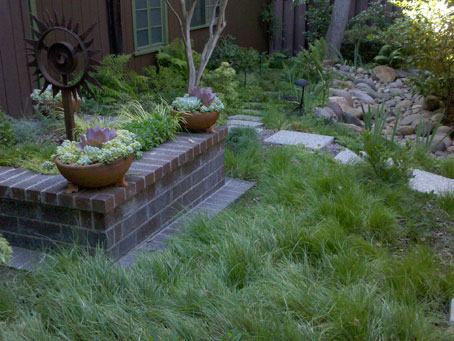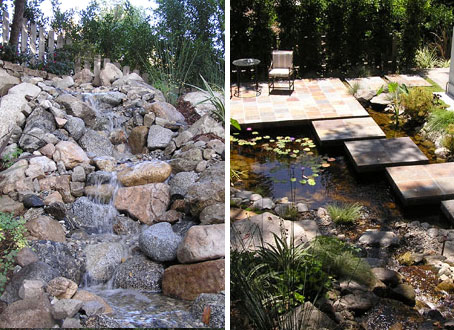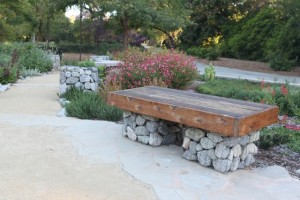BUILDING-IN WATER CONSERVATION
By Cassy Aoyagi: New statewide Water Efficiency Landscape Ordinances (WELOs) require or encourage new landscapes greater than 2500 square feet to keep or filter rainwater onsite. Infiltration, like rainwater harvesting and graywater, can accomplish this goal.
Also called percolation, infiltration is where rainwater is guided by a combination of landscape strategies to permeate into the ground. Like rainwater harvesting, infiltration filters rainwater; however, it does not necessarily store this water on-site. Infiltration is also distinguishable from graywater, which is reuse or recycling of water, in that it is not utilizing water twice but simply a method of capturing on site run-off water from roofs and paving.
Cities have profound reasons for encouraging infiltration. Infiltration protects homes and communities from floods caused by overtaxed public waterways; saves aquifers from pollution; and protects surfers and other ocean wildlife from the fertilizers, pesticides and animal waste that run off hardscapes and head for the ocean. Infiltration also protects homes by slowing fast moving water to reduce erosion and sedimentation, increases local water availability by recharging the water table, and cleans water naturally, using vegetation and soil as natural filters.
While rainwater collection and graywater systems often require strategies for concealment to ensure the visual integrity of the landscape, infiltration can be used to enhance a design. For example, the seemingly dry riverbed pictured above re-routes water away from the home and acts as a stabilizer. Like the dry stack walls on the slope, the riverbed is integral to the beauty and balance of the landscape design. This desert look is appropriate to the home’s design and La Crescenta hillside neighborhood, but it is far from the only look infiltration systems can support. The dry riverbed below adds a rugged charm to an otherwise soft, lush, green space.
Likewise, the waterfall and biological pond below, while perpetually riparian, allow a certain amount of water to be captured and filtered prior to leaving the site.
Infiltration can be achieved using French drains, percolation pits, creeks and waterfalls or even thoughtful grading. As you may have guessed, each of thepermeable patios featured in this month’s FormLA® client spotlight also encourage water to filter through their respective properties prior to leaving the site.
One critical caveat: While rainwater harvesting can be a DIY activity, the cost of failure with infiltration is high. A poorly constructed dry riverbed, for example, could actually destabilize a slope or flood a home. A lovely, thoughtful design is not enough. Choosing a knowledgeable, skilled install and construction team is a must to ensure both the beauty and the critical benefits are achieved.


